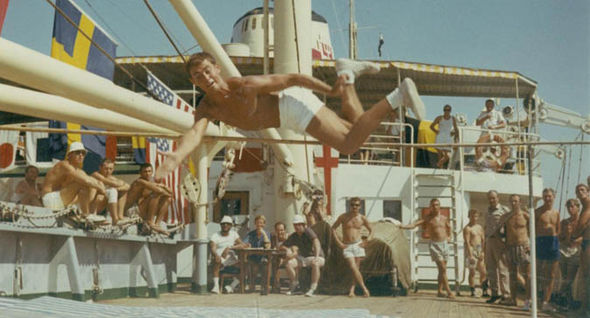The Last Time the Suez Canal Was Blocked a Utopian Communist Micronation Was Formed at Sea
The plight of Ever Given, the giant dick-drawing cargo ship, is over. For six days, the giant container ship blocked the Suez Canal, captivating the world and preventing sex toys and other important goods from making it to their destinations in a timely fashion. We laughed, we memed, but we did not remember our history.
The last time ships got stuck in the Suez Canal, they were there for eight years. From 1967 to 1975, in the aftermath of the Six-Day War, 14 ships were stranded in the Great Bitter Lake, a salt lake connected to the canal. Unable to leave, the crews, dubbed the "Yellow Fleet" because of the desert sand that eventually covered them, developed their own society at sea. This society developed its own postal service and stamps, and held a version of the Olympics in 1968.
The ramifications of stranded ships also led directly to the creation of the mega-container ships we see now, which may have helped lead to the Ever Given saga.
The trouble began in June 1967. Egypt and Israel went to war in what's now called the Six-Day War. Though that specific conflict only lasted six days, the fallout from it would stretch on for decades. Peter Flack was serving as the third mate on the British ship the MS Agapenor. The captain, communicating by pipe and whistle, called up to tell me he'd just heard that war had broken out between Israel and the Arab states," Flack told author Cath Senker for the book Stranded in the Six-Day War. If you see anything unusual, please let me know but don't tell the Egyptian pilot."
As part of the conflict, Egypt blockaded the Suez Canal. It blocked both ends of the canal with scuttled ships, debris, and sea mines to prevent its use by Israeli forces. The Agepnor and other ships sailing from West Germany, Sweden, France, the United Kingdom, Poland, Bulgaria, Czechoslovakia, and the United States were stranded. The ships floated in the canal and watched the war unfold around them.
The world was less connected in 1967 than it is today. The ships had access to radios and were able to call home, but Egyptian authorities eventually asked them to stop. As the crisis wore on, the Canadian government negotiated the exchange of crews from the ships. Supplies came in from Egypt, some sailors went home and others stayed on, but Egypt would not allow the ships to leave the canal.
Over the next eight years, a weird system developed. The companies that owned the ships were allowed to cycle crews through the ships, maintaining skeleton crews to keep them afloat, but weren't allowed to sail the ships out of the canal. As time passed, the ships communicated with each other and grew into a community. They formed the Great Bitter Lake Association to administer to the needs of the crew.
According to a TIME article from 1969, the crew's biggest problem was boredom. To while away the time, they take part in lifeboat races and play soccer on the broad deck of the largest ship, the British bulk carrier Jnvercargill," TIME said. They attend church services on the West German motorship Nordwind and watch movies on the Bulgarian freighter Vasil Levsky. The Polish freighter Djakarta even prints stamps for the marooned vessels. Egyptian postal authorities graciously allowed the stamps to be used as legal postage; they have become collector's items. Immense amounts of beer are consumed in the heat. Says one crewman: There must be five feet worth of beer bottles on the bottom around each hull by now.'"
The ships pooled resources, including food and beer, and developed a system to keep everyone fed during the crisis. In addition to stamps, the sailors created dinnerware and patches to show their association with the GBLA. In 1968, the GBLA ran its own Olympic Games 10 days ahead of the real thing. The crews competed in 14 events, including diving, sprinting, high jump, archery, and water polo. Polish crews even minted medals to hand out at an awards ceremony. A soccer playing dog named Bullbul participated in the games and was awarded a medal.
 Peter Flack photo
Peter Flack photo Things continued this way aboard the ships until 1975 when Egypt lifted the blockade at the end of the Yom Kippur War. Only two of the ships were able to leave on their own power. Weather, neglect, and repeated salvage operations had worn out the other 12. Fifty years on, the surviving crew of the ships meets infrequently and keeps the story alive online. Many of them describe the period as one of the happiest of their lives.
The legacy of the Suez Canal blockade was a direct cause of the Ever Given's predicament. Up until the Six-Day War, the size of the tankers was limited so that they could go through the canal. The largest to go through was a 150,000 deadweight tonnage Norwegian tanker," Senker said in Stranded in the Six-Day War. After the canal closed, there was an almost overnight demand for a 25 percent increase in oil tanker capacity.' The shipping companies began to build ever-bigger supertankers, and there was an explosive growth of merchant fleets.'"
The Ever Given is a 220,000-ton ship, one of the supertankers created by shipping companies in the wake of the Suez Canal blockade. The Ever Given is free again, so we won't see a New Society pop up in the canal. But it's a nice chance to remember one of the world's weirdest communities.